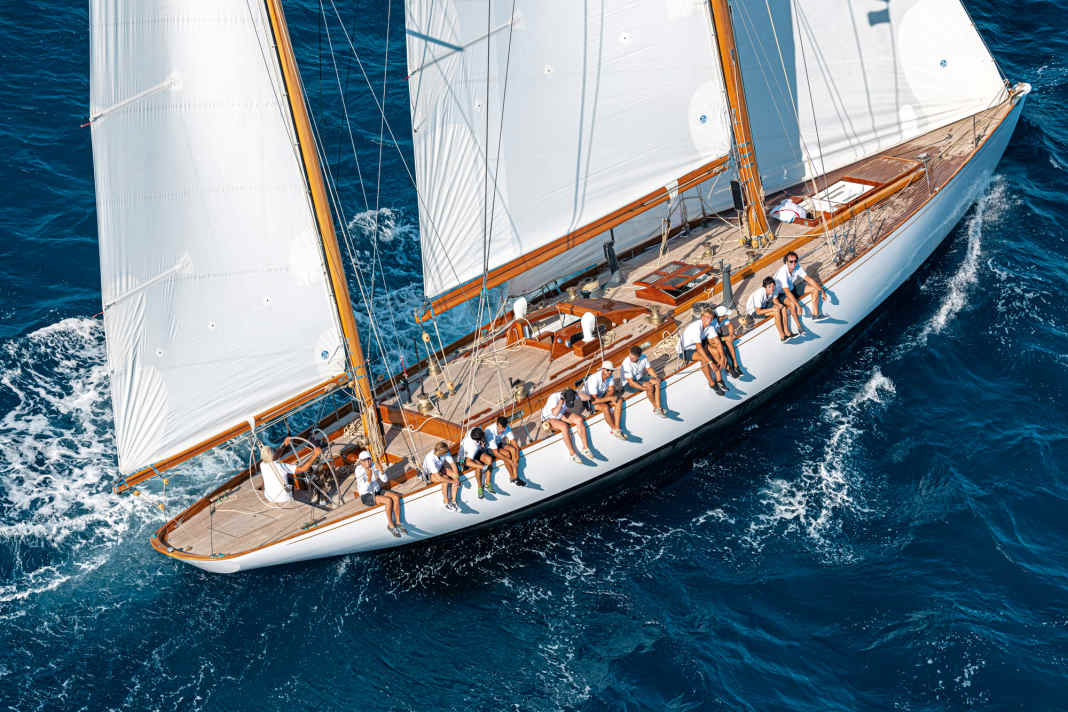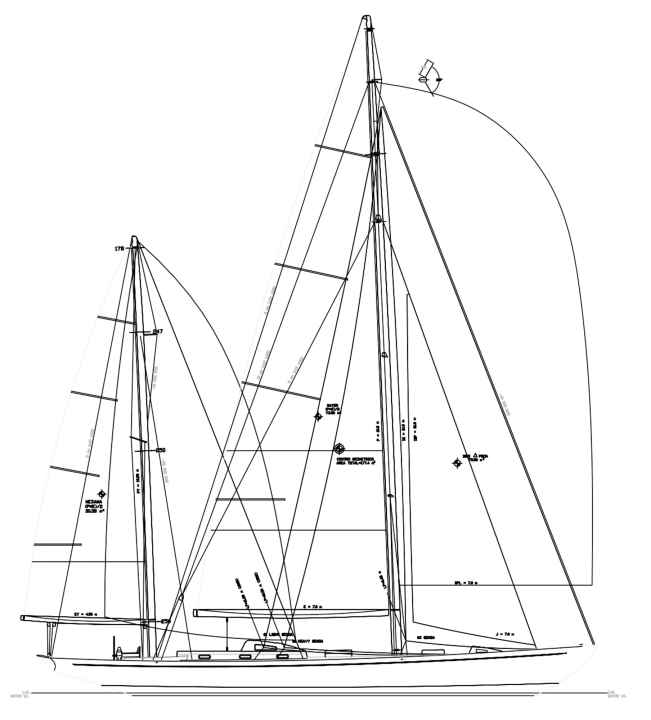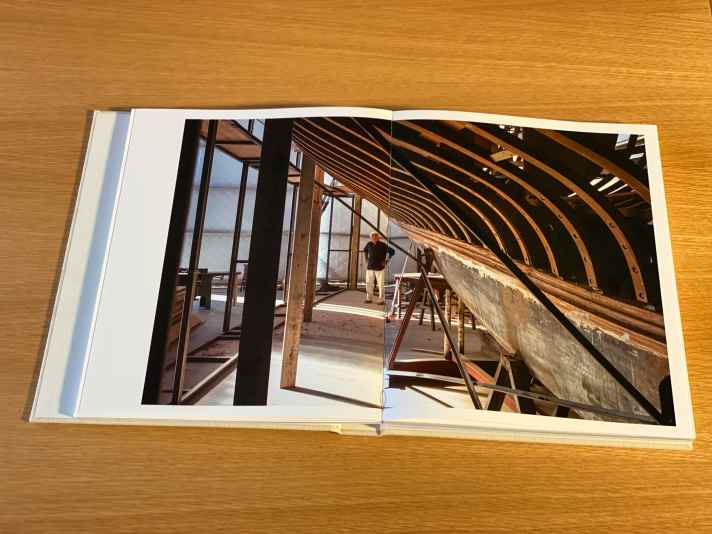"Recluta": Germán Frers built a 70-year-old construction as a tribute to his father






- The history of the "Recluta" is linked to that of the Frers family
- There is Germán's desire for a yacht on which he can sail with family and friends
- Although "Recluta" is intended to be a tribute to the father, it will not be an original replica
- Technical data of the "Recluta"
- The book about the boat
It's not easy to stand out with a classic yacht in the old town harbour of Saint-Tropez at the end of September. Because opposite the "Café de Paris" in the evening during the cult regatta "Les Voiles", all the big names on the scene line up: the "Moonbeam of Fife"Historic eights and twelve-wheelers almost get lost in this open-air museum of early yacht building. However, one boat, the youngest of them all, always causes small processions on the quay last autumn: "Recluta".
The crews of the competition stand just as devoutly in front of her as onlookers and shiplovers, some of whom have travelled from far and wide. And for good reason. The 20-metre ketch, which measures just over 14 metres in the waterline, is considered an absolute rarity even in these circles. The seamless curve with which the cedar-planked hull merges into the heart-shaped transom. The masts tapered towards the top with their finely forged fittings. The straight teak mouldings that make the deck of the already imposing boat appear even larger, even longer. The flat superstructure. The even paintwork. Everything about this yacht breathes the spirit of something special. Even the oversized Dorade fans and the all too mundane stainless steel steering wheel in the aft cockpit, even the maxi displays, grinder pillars and Dyneema lashings do not diminish the authenticity of this work of art. "Recluta" is a boat to kneel down on, no matter what angle you look at it from, no matter who is in its vicinity.
Also interesting:
And yet it's not just the sheer aesthetics that make it stand out. Not the quasi-new condition of this classic. Nor is it just the name of her owner or the fact that she took first place in her class on the second day of the regatta and third place at the end of the week. The special thing is that it has taken almost eight decades to get to this moment.
The history of the "Recluta" is linked to that of the Frers family
The story of the "Recluta" goes back even further, 120 years in total, and is full of twists and turns, some tragic, some sad. Above all, however, it is a parable for the passion that unites sailors, yacht builders and designers. It's a story that - if you didn't know that it actually happened - couldn't possibly be true. And of course, and above all, it is the story of the fabulous Frers family.
The man who owns the ketch, who had it built, bears this name. It is none other than Germán (pronounced: xer'man) Frers, who has designed every Hallberg-Rassy and almost every Swan for decades. His daughter Zelmira, who accompanied the construction with her camera and notebook, has the same name, as does her brother Mani, who is part of the family crew in Saint-Tropez, along with his son.
Of course, "Recluta's" designer also goes by this name: Germán Frers, whom they still affectionately call "Papa" or, more respectfully, "Don Germán" at home. He, the senior, began developing yachts as early as 1925, and was extremely successful. Like so many greats of the early boatbuilding era, he was first and foremost a sailor and secondly self-taught. Although he studied engineering for a few semesters, he did not set great store by a degree. "He saw himself more as a draughtsman, an artist than an engineer," says his son Germán in an interview with YACHT.
Filius was not even a year old when a serious accident occurred in February 1942 during the South Atlantic Ocean Regatta between Buenos Aires and Mar al Plata. On the second night after the start, the Argentinian Charlie Badaracco sets a tack too late and gets stuck on the flat off Cabo San Antonio with his ketch "Recluta", built by Camper & Nicholsons in 1901. The skipper and crew manage to sail free again, but in the hectic manoeuvre a crew member goes overboard.
At 67 feet, the new "Recluta" would have been the largest private yacht ever built in Argentina up to that point
The others have to turn back again to try and rescue their mate, and head for the shallows once more. Although they are able to pick up their mate again, they run aground a second time - and this time there was no escape. While the crew managed to save themselves on land, "Recluta" was driven higher and higher onto the beach by the wind, tide and surf. All attempts to salvage her in the following days failed. What could have been her end, and an inglorious one at that, was in fact to be a new beginning. It was not long before Charlie Badaracco decided to commission a new ketch modelled on the lines of the old one. Between 1943 and 1944, Germán Frers, the senior, drew no fewer than 25 plans for him, including watercolour sketches, which hung on the walls of his studio until the 1970s and are still kept in the company archive today.
At 67 feet, the new "Recluta" would become the largest private yacht ever built in Argentina - the pride of an entire nation and the showpiece of its designer, who was highly respected in the country but hardly known internationally. The magazine "Yachting Argentino" reported on the project on several pages. Then, however, during the turmoil of the world war and the resulting shortage of raw materials, "Recluta" ran aground again, albeit this time only in a figurative sense. Due to a lack of lead, copper and bronze, construction, which had already begun, had to be postponed again and again - until it was eventually cancelled altogether.
For a good 70 years, the boat existed only on paper, in the drawer of a wooden filing cabinet - and in Frers' memory. "Such beautiful lines," his son hears the old man say as he once again looks at the blueprints in his office. "What a shame it was never built."
There is Germán's desire for a yacht on which he can sail with family and friends
It must have been moments like these that persuaded the now 81-year-old "Junior" to complete his father's work after all. Coincidence probably also played a role, if not coincidence. In any case, a lot came together when the "Recluta" project secretly, quietly picked up speed again in 2016. There is the shipyard that Germán Frers donated to his club, the Yacht Club Argentino San Fernando, just 20 minutes away from his house. It is currently empty. There is Tito Szyjka, 84, the gifted carpenter and friend who has been building boats for Frers since the 1960s. He and his two grandsons, as well as a handful of other skilled craftsmen, are currently without orders.
There is Germán's desire for a yacht on which he can sail with family and friends, one with soft, harmonious lines and gentle movements in the swell. An age-appropriate boat, if you like. And then there is another motive, much less tangible, but no less decisive for the decision to build "Recluta". Something that has driven Germán Frers his entire career: "To make tangible what my father built early on in Argentina, so far away from the traditional centres of yacht building."
From the moment he digitises the old cracks and resurrects "Recluta" in 3D on the computer, the new building will challenge and captivate him for five years. Soon he will be turning up in the hall every day to talk to Tito and the others about the work, about details, about the schedule, sometimes even about this and that.
Although "Recluta" is intended to be a tribute to the father, it will not be an original replica
There he stands, this icon of a designer, tall, towering over his foreman by more than head length, his shirt sleeves usually rolled up, his gestures firm, his gaze determined, at times aristocratic and stern. A man who would also pass for an owner at the helm of a 120-foot Nautor maxi, not just an "Ingeniero". And yet Zelmira, his daughter, sees him "like a little boy who loses track of time in his favourite place".
Although the boat that is being launched will be a tribute to his father, it will not be an original replica. Even the old plans were a replica, a further development of the original Camper & Nicholsons ketch. And so the son is also taking "a few liberties", as he tells YACHT. He has made the cockpit for the helmsman wider, the hatches bigger, the cabin superstructure and companionway longer. He also chooses different technical and structural approaches in some cases.
He does not have the keelson, ribs and stem carpentered from solid wood, but glued in 3D-milled moulds made from strips. He uses local Viraró wood, almost unknown in this country, but an excellent choice due to its high density and rot resistance. The hull is planked with cedar. Frers has the deck built in two layers: Firstly, a layer of plywood is laid over the deck beams; this is prefabricated and placed on the hull using a mobile crane. This is followed by a teak deck with bars almost the width of a hand, laid in the classic way, strip by strip.
The designer also goes his own way when it comes to mast construction. He commissioned a German colleague, Juliane Hempel, to design the rig. The wooden masts she designs from the finest Sitka spruce are considered unrivalled in the scene. She was awarded the contract in Saint-Tropez in 2018 when she was discussing the details with Germán Frers in a café in the evening. For Hempel, it is "an accolade", as she says; she was "very touched" to work for such a great yacht designer. "And what's more, he's such a great person!"
Germán Frers' father, the architect of the "Recluta", would have been proud
Where "Recluta" deviates the most from the original will remain invisible to most admirers. It is the extension, which is the area with the greatest room for interpretation in the classic scene anyway. In order to be able to use the boat for longer holiday trips, Frers envisages more headroom and a more usable cabin layout. It is true that he cannot eliminate the cramped conditions typical of modern yachts. But he has created a cosy, stylish environment for four to six guests. It even accommodates a double berth in the stern, as is standard on cruising boats today.
To avoid being too heavy, bulkheads and doors are made of moulded kiri, a particularly light, even and expensive wood. It is veneered with light-coloured chestnut, a rare and distinctive choice. With the white contrasting deck beams, the white upholstery and the natural light that falls through the skylights, the boat has a friendly, gloomy appearance. Charlie Badaracco, who once commissioned it, would have been very proud to see it. Germán Frers' father, the architect, would no doubt have been too.
And the junior who realised it all in the end? Who didn't order a Hallberg-Rassy 57 or a Swan 65, but realised "Recluta" - what does he think about the Ketch, about this cross-generational project? What was it like for him to rediscover the traces of his father? "It was exciting to see his handwriting and his calculations on the plans. To construct once again what he had drawn. It's a source of great satisfaction. A way of being close to him. "At the helm in Saint-Tropez, surrounded by friends and family, you could sometimes see an expression of deep fulfilment behind his concentration.
Frers, who has drawn hundreds of yachts, says that he learnt to love "Recluta" on the crossing from Menorca to Antibes. "Who knows, maybe I'll keep her forever."
Technical data of the "Recluta"

- Designer: Germán Frers Sr.
- Torso length: 20,34 m
- Waterline length: 14,61 m
- Width: 4,56 m
- Draught (centreboard o./u.): 2,36/4,80 m
- Theoretical torso speed: 9.3 kn
- Weight (empty/sail clear): 33,0/36,4 t
- Mast height above WL: 25,30/16,70 m
- Mainsail/mainsail: 73,5/30,4 m2
- Genoa 3 (97 %): 71,2 m2
- Sail carrying capacity (STZ): 4,1
The book about the boat

The development of "Reclutas" from plan to ready-to-sail yacht took a small eternity. Zelmira Frers accompanied the construction for four years and published a wonderful book about it. It is itself a small work of art, both in terms of craftsmanship and content, because it conveys on several levels the fascination that turned her grandfather and father into yacht builders. Absolutely worth seeing and reading!
258 pages, cloth binding, 75 euros, direct purchase: thestorybehindrecluta.com
The article first appeared in YACHT 05/2022 and has been updated for the online version.

